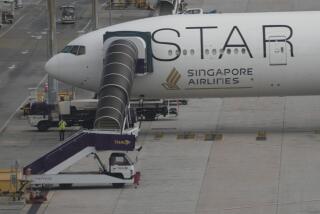Investigators probe cause of rupture in side of plane
A rupture in the side of a Qantas Airways 747 jumbo jet Friday alarmed air travelers worldwide as investigators launched a probe into how it happened and what was to blame.
Qantas passengers were dispatched on other planes to their destinations as the damaged aircraft was being inspected in Manila by Australian and U.S. accident investigators, including a team from Boeing Co., the Chicago-based manufacturer of the aircraft.
The incident may seem far away and only distantly important to some. But, in a way, it was jarringly close: The plane involved in Friday’s incident often flew passengers between Los Angeles International Airport and cities in Australia, even as recently as Tuesday, according to the aircraft’s flight manifest.
Kathy Bosworth, a Dallas resident who was waiting at LAX for her daughter’s Qantas flight from Sydney, said she “just froze” when TV shows aired the incident Friday morning.
Televised video footage taken by a passenger showed the inside of the plane, and Bosworth said the back of another woman’s head looked exactly like her daughter.
“I literally held my breath. And it was five minutes before they said which flight it was,” Bosworth said.
Her daughter, Erin Hunt, didn’t know about the incident, which she said was “very unlike Qantas.” Hunt flies the airline every couple of months.
“I think it was a fluke. I still trust the safety of Qantas. I’ll be interested, though, in what happened,” Hunt said.
Several Australians flying into LAX said they aren’t worried about the safety record at Qantas, Australia’s largest airline.
“I’m alive and here to talk about it,” said Matt Fry, 30. “I only fly Qantas. They’ve got the best safety record of any airline in the world.”
The 2-foot-by-5-foot hole in the side of the jumbo jet carrying 346 passengers over the South China Sea forced the pilot to make an emergency landing in Manila after a rapid descent.
The images of the damage were eerily similar to the harrowing 1988 incident in Hawaii in which an Aloha Airlines plane flying from Hilo to Honolulu lost an 18-foot section of its skin, killing a flight attendant who was ejected from the jet.
The Qantas flight, which originated in London with a stopover in Hong Kong, was on its last leg home to Melbourne, Australia. It was cruising at 29,000 feet when a loud bang rattled the plane, according to passenger accounts. A video taken by a passenger shows people wearing their oxygen masks as the jet descended to 10,000 feet.
There were no injuries, but some passengers vomited after disembarking and seeing the hole in the plane, said Octavio Lina, deputy manager of operations for the Manila International Airport Authority.
At first glance, the damage appeared larger because a covering about the size of a small car that was over the rupture had also been blown away. The so-called fairings are lightweight composite materials used to smooth out the fuselage to reduce wind drag.
An official at the U.S. Transportation Security Administration, who spoke on condition of anonymity, told the Associated Press that the initial reports showed that the incident was not related to terrorism.
Several aviation safety experts who viewed the images of the damage said it was too early to speculate but that investigators would know relatively quickly whether a bomb caused the damage.
“There will be residue pointing directly to an explosion,” said Barry Schiff, a retired airline pilot who is now an aviation safety consultant in Camarillo. “If not, it will take a lot of study to find out what caused the structure to fail. They’re not going to know overnight.”
Hans Weber, an aerospace consultant in San Diego, said he was puzzled by the rupture because it was not in “one of the high-stress areas” of the plane were metal fatigue could have played a part as it did for the Aloha plane. “That would be way down my list of suspects,” he said.
In Australia, a Sydney newspaper reported that the plane had been plagued by a history of corrosion. Citing aviation sources, the newspaper said Qantas engineers discovered a large amount of corrosion in the plane during a major refurbishment this year. The report did not say whether anything was done about the corrosion, and a Qantas spokeswoman said Friday that the airline could not comment until the incident investigation was completed.
The 747 is one of the most widely used long-haul planes and is ubiquitous at LAX’s Tom Bradley International Terminal. Boeing has built more than 1,000 747 planes since they entered commercial service in 1970. The most recent variant, the 747-400, is flown by many of the largest airlines today. Qantas operates three 747-400 jets a day for flights from LAX to Australia.
Placed into service in 1991, the plane involved in the incident has typically been used for the so-called Kangaroo Route that connects London with Australia. But when not flying to London it flies between LAX and Australia. It flew the Los Angeles route at least eight times this month.
--
Times Staff Writer Kimi Yoshino contributed to this report.
More to Read
Sign up for Essential California
The most important California stories and recommendations in your inbox every morning.
You may occasionally receive promotional content from the Los Angeles Times.










